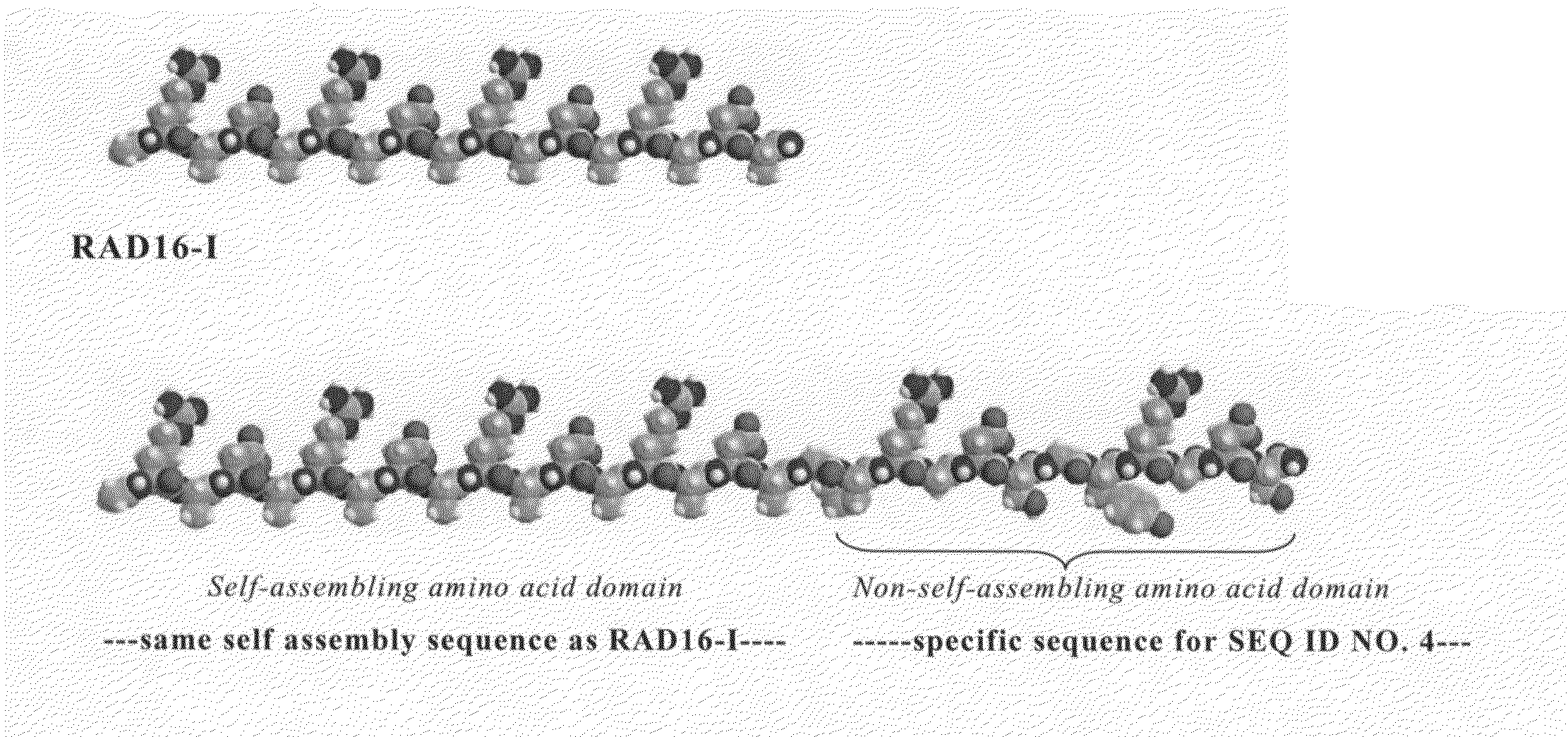Modified self-assembling peptides
a technology of peptides and peptides, which is applied in the direction of peptide sources, prosthesis, peptide/protein ingredients, etc., can solve the problems of difficult to ensure that different preparations of materials have a consistent, reproducible composition, and increased risk of disease transmission, so as to prevent or lessen the likelihood of disease development, reduce the severity of disease, and reduce the risk of diseas
- Summary
- Abstract
- Description
- Claims
- Application Information
AI Technical Summary
Benefits of technology
Problems solved by technology
Method used
Image
Examples
example 1
Pre-Osteoblast Proliferation and Differentiation Effects
[0396]Recently, due to the aging society, problems associated with bone degeneration and bone fracture has become a significant problem both for quality of life of the patient and the social medical cost. Bone fracture in an older person is a prevalent problem due to osteoporosis but also due to poor bone regeneration. Thus, the acceleration of bone regeneration by implanting biomaterials and / or a tissue engineering approach are of interest. Also of interest is the enhancement of osteoblast activity mineralization and pre-osteoblast or stem cell proliferation differentiation.
[0397]Bone regeneration was tested using functional motifs as provided in Table 2 (Synpep Corporation). Mouse preosteoblast cell line (MC3T3-E1) was used to compare the proliferation and differentiation effects of the motifs with RAD16-1 and Collagen-I hydrogels as controls. The proliferation was measured by DNA contents and the differentiation effects were...
example 2
Effect of the Mixed Ratio of Functionalized Peptide
[0410]Effect of a mixture of self-assembling sequence peptide (e.g., 1% RAD16-1 peptide solution) and a functionalized peptide (SEQ ID NO. 7) with self-assembling sequence (RADA) and functional motif (RGD), was evaluated (Tables 8-9) SEQ ID NO. 7 has an additional Glycine at the N-terminus (compared to SEQ ID NO. 4), which causes an increase in hydrophobicity of the hydrogel. Biologically SEQ ID NO. 4 and SEQ ID NO. 7 are considered to have similar effects.
TABLE 8No.SequenceDescriptionSEQ ID NO.7Ac(RADA)4Repetitive RGDGPRGDSGYRGDSGCONH2binding sequence
TABLE 9Hydrogel contentsCodeHydrogel contentsRAD1% RAD16-1 peptide solutionDSG1% SEQ ID NO. 7 peptide solution
[0411]Hydrogels were prepared so that the mixture ratio of RAD and DSG was varied from 100:0 to 0:100 (FIG. 8). Cells were prepared and seeded as described in Example 1. Cells were cultured on hydrogels for 7 days. Cell proliferation was evaluated using DNA contents in the hydr...
example 3
Three Dimensional Culturing Using the Charged Functionalized Motif
[0414]Self assembling peptides hydrogels described above and herein provides cells with a synthetic extra cellular matrix (ECM) environment for 3-dimensional growth similar to that of collagen. When seeding the cells 3 dimensionally, the self assembling peptide solution should be stored at low pH (usually a pH of between 2-3) to keep viscous solution state. However, mixing living cells into low pH solution for long time significantly impacts cell viability (e.g., it is known that a few minutes in pH 2-3 solution, most human cell viability is significantly lost). Thus, when seeding the cells with a solution of the self assembling peptide at low pH, (1) the cells are added, and (2) the pH is immediately brought to near-neutral (pH between 5-8) or basic.
[0415]FIG. 10 shows the isoelectric plot and corresponding rheological rheological data when 0.1 N NaOH solution is added to RAD16-1 1% solution. At the point of pH 3.6, ...
PUM
| Property | Measurement | Unit |
|---|---|---|
| Fraction | aaaaa | aaaaa |
| Pore size | aaaaa | aaaaa |
| Distance | aaaaa | aaaaa |
Abstract
Description
Claims
Application Information
 Login to View More
Login to View More - R&D
- Intellectual Property
- Life Sciences
- Materials
- Tech Scout
- Unparalleled Data Quality
- Higher Quality Content
- 60% Fewer Hallucinations
Browse by: Latest US Patents, China's latest patents, Technical Efficacy Thesaurus, Application Domain, Technology Topic, Popular Technical Reports.
© 2025 PatSnap. All rights reserved.Legal|Privacy policy|Modern Slavery Act Transparency Statement|Sitemap|About US| Contact US: help@patsnap.com



